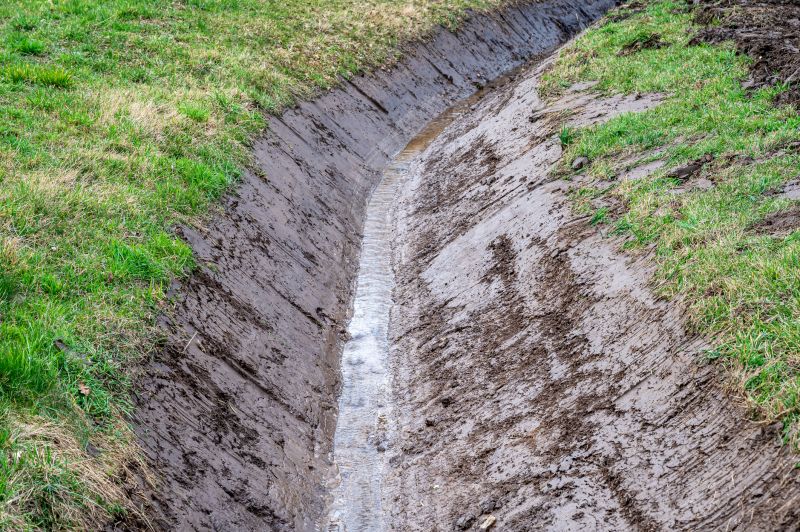Leading Drainage Service Tools That Enhance Your Maintenance Capabilities
Browse top-rated equipment engineered to improve efficiency and reliability in drainage system servicing.
 Effective drainage is essential for maintaining the integrity and safety of residential, commercial, and industrial properties in Cincinnati, OH. Proper drainage solutions help prevent water accumulation, reduce erosion, and protect structures from water damage. From clogged gutters to underground piping issues, addressing drainage concerns requires a variety of specialized products designed to manage water flow efficiently. Understanding the different types of drainage products available can help property owners select the most suitable solutions for their specific needs.
Effective drainage is essential for maintaining the integrity and safety of residential, commercial, and industrial properties in Cincinnati, OH. Proper drainage solutions help prevent water accumulation, reduce erosion, and protect structures from water damage. From clogged gutters to underground piping issues, addressing drainage concerns requires a variety of specialized products designed to manage water flow efficiently. Understanding the different types of drainage products available can help property owners select the most suitable solutions for their specific needs.
Top Overall Option
Drainage Channel System
A drainage channel system offers a versatile and effective solution for managing surface water runoff. Designed to be installed along driveways, patios, and walkways, these systems typically consist of modular, durable channels with grates that facilitate water flow while preventing debris entry. They are suitable for various property sizes and can be customized to fit specific landscape contours. Properly installed, drainage channels can help direct water away from foundations and reduce pooling issues, making them a practical choice for many property owners in Cincinnati. Selecting a high-quality, corrosion-resistant material ensures longevity and reliable performance in diverse weather conditions.
Types of Products For Drainage Service
French Drains
Subsurface drainage solutions that channel water away from problem areas through a gravel-filled trench with perforated piping.
Surface Drainage Grates
Protective grates installed over open drains to prevent debris entry while allowing water to flow freely.
Catch Basins
Receptacles that collect surface water and direct it into underground drainage pipes.
Sump Pumps
Devices used to pump accumulated water from basements or low-lying areas to a safe drainage point.
Channel Drains
Linear drainage systems that effectively channel surface water away from paved areas.
Gutter and Downspout Extensions
Components that extend roof gutters to direct water further away from foundations.
Drainage Pipes
Flexible or rigid piping systems designed to transport water from collection points to drainage outlets.
Soil Stabilization Fabrics
Materials used to reinforce soil and prevent erosion around drainage installations.
Rain Barrels
Containers for collecting rainwater from roofs, reducing runoff and providing water for landscaping.
Water Diverters
Devices that redirect surface water away from vulnerable areas to prevent pooling.
Perforated Pipe Systems
Drain pipes with small holes that facilitate water infiltration into surrounding soil.
Erosion Control Mats
Protective coverings that stabilize soil and prevent erosion around drainage features.
Drainage Trenches
Shallow excavations filled with gravel or other media to facilitate surface water flow.
Swales
Shaped or graded depressions designed to direct runoff safely away from structures.
Vortex Drainage Units
Drainage solutions that utilize vortex technology to efficiently manage high volumes of water.
Popular Choices
Commonly used to alleviate ground water buildup around foundations and landscaping areas.
Widely installed in driveways and walkways to manage surface water runoff.
Frequently used in parking lots and streets to collect and redirect stormwater.
Popular for basement waterproofing and managing water accumulation in low-lying areas.
Effective in directing water away from paved surfaces and preventing flooding.
Commonly added to existing gutters to improve water diversion from foundations.
Versatile piping options used in various drainage projects around properties.
Popular among homeowners for collecting rainwater for irrigation and reducing runoff.
Often used to redirect surface water away from vulnerable areas or structures.
Widely employed in French drain systems and subsurface drainage applications.
Chosen for stabilizing slopes and disturbed soil around drainage features.
Commonly installed in yards and gardens to facilitate water flow.
Effective landscape features for managing runoff in larger properties.
Gaining popularity for their high-capacity water management in commercial settings.
Drainage products encompass a wide range of items, including surface drainage systems like channel drains and catch basins, as well as subsurface options such as French drains and sump pump systems. Proper installation and maintenance of these products can mitigate common drainage problems caused by heavy rainfall or poor landscape grading. It is important to evaluate the particular conditions of your property, such as soil type, slope, and existing infrastructure, to determine the most effective drainage solutions.
In Cincinnati, where seasonal weather variations can lead to significant water runoff, selecting reliable and durable drainage products is vital. Quality materials and appropriate installation techniques ensure longevity and optimal performance. Consulting with local experts or suppliers can provide insights into the best practices for drainage management tailored to Cincinnati’s climate and terrain. Regular inspection and maintenance of drainage systems can prevent blockages and ensure continuous water flow, reducing the risk of flooding or water damage over time.
Key Buying Considerations
- Assess the specific drainage problem to determine the appropriate product type.
- Consider the volume of water expected during heavy rainfall events.
- Evaluate the soil type and permeability to choose suitable underground drainage solutions.
- Check material durability, especially for outdoor exposure and weather resistance.
- Determine the required capacity and size of the drainage system based on property dimensions.
- Ensure compatibility with existing infrastructure such as gutters, pipes, or landscaping features.
- Review installation requirements and whether professional help is needed.
- Factor in maintenance needs, including cleaning and inspection routines.
- Select products that meet local building codes and regulations in Cincinnati, OH.
- Consider ease of access for future repairs or modifications.
- Opt for corrosion-resistant materials for long-term performance.
- Evaluate the aesthetic impact and how the system integrates with landscape design.
- Check for availability of replacement parts and accessories.
- Review product warranties and supplier support options.
- Estimate overall project costs, including installation and ongoing maintenance.
